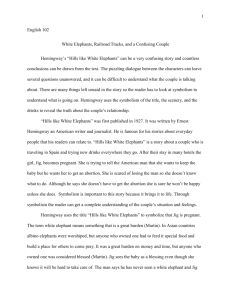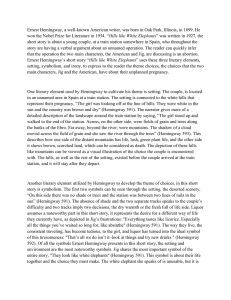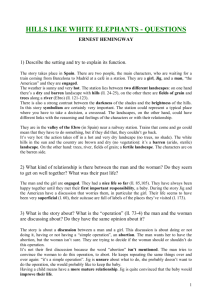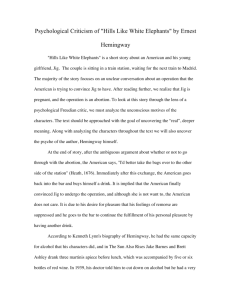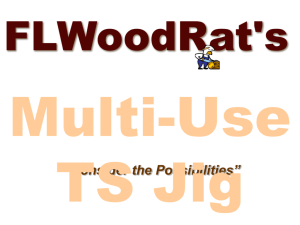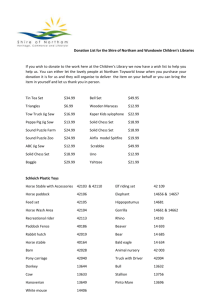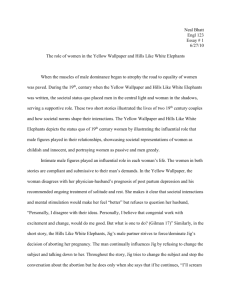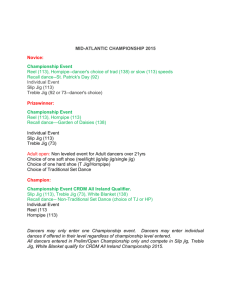hemingway`s "hills like white elephants"
advertisement
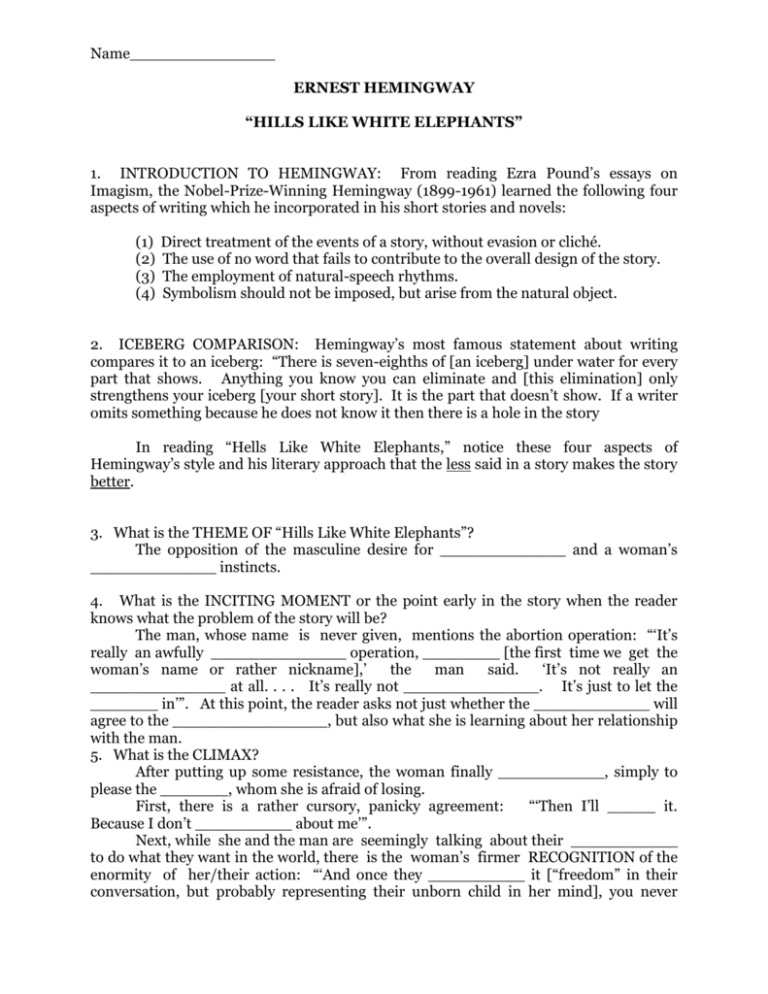
Name_______________ ERNEST HEMINGWAY “HILLS LIKE WHITE ELEPHANTS” 1. INTRODUCTION TO HEMINGWAY: From reading Ezra Pound’s essays on Imagism, the Nobel-Prize-Winning Hemingway (1899-1961) learned the following four aspects of writing which he incorporated in his short stories and novels: (1) (2) (3) (4) Direct treatment of the events of a story, without evasion or cliché. The use of no word that fails to contribute to the overall design of the story. The employment of natural-speech rhythms. Symbolism should not be imposed, but arise from the natural object. 2. ICEBERG COMPARISON: Hemingway’s most famous statement about writing compares it to an iceberg: “There is seven-eighths of [an iceberg] under water for every part that shows. Anything you know you can eliminate and [this elimination] only strengthens your iceberg [your short story]. It is the part that doesn’t show. If a writer omits something because he does not know it then there is a hole in the story In reading “Hells Like White Elephants,” notice these four aspects of Hemingway’s style and his literary approach that the less said in a story makes the story better. 3. What is the THEME OF “Hills Like White Elephants”? The opposition of the masculine desire for _____________ and a woman’s _____________ instincts. 4. What is the INCITING MOMENT or the point early in the story when the reader knows what the problem of the story will be? The man, whose name is never given, mentions the abortion operation: “‘It’s really an awfully ______________ operation, ________ [the first time we get the woman’s name or rather nickname],’ the man said. ‘It’s not really an ______________ at all. . . . It’s really not ______________. It’s just to let the _______ in’”. At this point, the reader asks not just whether the ____________ will agree to the ________________, but also what she is learning about her relationship with the man. 5. What is the CLIMAX? After putting up some resistance, the woman finally ___________, simply to please the _______, whom she is afraid of losing. First, there is a rather cursory, panicky agreement: “‘Then I’ll _____ it. Because I don’t __________ about me’”. Next, while she and the man are seemingly talking about their ___________ to do what they want in the world, there is the woman’s firmer RECOGNITION of the enormity of her/their action: “‘And once they __________ it [“freedom” in their conversation, but probably representing their unborn child in her mind], you never Name_______________ _________ it back”. At this point, looking at the hills which she had earlier compared to “__________ elephants”, she calls them “dry” —probably a symbol of sterility or of the _________________ which he wants her to have. Her final attempt to save the unborn child is the CLIMAX of the story, since she asks a question of which she now knows the answer: “‘Doesn’t it [the baby, but also, in a sense, their relationship] __________ _______________ to ______?’” . 6. What kind of life have the CHARACTERS presumably led up to the point at which the story opens? Jig and the man have led a migratory life, as the labels on their bags suggest: “There were labels on them [the bags] from all the _________ where they had spent nights”. This rootlessness or their absence of a fixed _________ probably figures in Jig’s implied wish to keep the child rather than _________ it as the man wants, since babies suggest stable homes and an end to wandering. 7. Who is the ANTAGONIST? The man, who is the boyfriend or husband of the woman. Not wishing to be tied down by a _______, he symbolizes a desire for ________________. To get his way, he makes the subtle threat to withdraw his love unless the woman agrees to the ________________. He bullies her and in the process reveals his ignorance about _______________ and insensitivity to what the woman is feeling or will have to endure physically. He is also a hypocrite since his bullying is accompanied by protests that he really wants only what she wants: “I wouldn’t have you do it if you didn’t _______ to” ; “I don’t want you to do it if you _______ that way”; “I don’t ________ you to do anything that you don’t _________ to do” ; and “I don’t __________ you to do it if you don’t __________to” . That he doesn’t really love Jig is seen at the end when he, having ____________ his goal of getting her to agree to the _____________, promises her that he will come back right away, after he moves their _______ . Instead, he stops in the _______ to have a ____________ by himself, where he notes—in a final dig at Jig—that all the other passengers were “_________________” waiting for the train, implying that Jig has been ____________________ in not agreeing right away to do what he wants. 8. Who is the PROTAGONIST? Jig, the woman, represents maternal instincts. On page , after asking him whether “it” (the baby) means anything to him, she reads into his hypocritical answer that not only does he not _________ for the baby, but also that he does not _________ for her on anything more than a physical-pleasure level. Her seven-time repeated “____________”—which some have interpreted to mean that she has seven months to go in the pregnancy—and her threat to “_______________” show her RECOGNITION of her helplessness in this ______-sided relationship. Name_______________ 9. What POINT OF VIEW is used in the story? Third Person Objective. The thirdperson __________ “he,” “she,” or “they” are basically used, not “I” or “you.” The story “objectively” reports the actions and conversations, but never enters the ____________ of either protagonist or antagonist. 10. What is the SYMBOLISM of the TITLE? Near the beginning of the story, the woman observes that the “hills” opposite the railway ___________ “look like ___________ ______________”. To the woman at this point, “elephants” would probably be a symbol of fecundity, her desire to have the __________. The ____________ irritated response to her simile shows that he is not inclined to consider any outlook which deals with having the ___________. Significantly, as quoted earlier at the Climax, “the girl looked across at the hills on the ________ side of the valley”. The word “elephants” is replaced by “________,” probably a symbol of sterility or the ________________. One should also consider the meanings of the phrase “white elephant”: it is, to quote Merriam Webster’s Collegiate Dictionary, 10th ed., “a property requiring much care and expense and yielding little profit” or “an object no longer of value to its owner but of value to others.” Both of these fit in with how the ___________ interprets the _____________ child. 11. How is the woman’s NAME perhaps SYMBOLIC? What is a “jig”? What is a “jigger”? What does the phrase, “the jig is up,” mean? How could these words or the phrase fit in with the man’s hedonistic view toward life? (1) Jig: A “jig” is a fast dance, thus fitting in with the ________ hedonistic, irresponsible view of life. A “jig” is also a mechanical device like a sieve or a drill, thus suggesting the ________________ impersonalism of their ______________. (2) Jigger: A “jigger” is a shot (glass) of liquor, again an association with the live_________-be-merry hedonistic view of the _______. (3) The jig is up”: This is a slang expression meaning “that ends it” or “all chances for success are gone,” both of which apply to the __________ and the unborn __________. Name_______________ ANSWER KEY 3. independence; maternal. 4. simple; Jig; operation; anything; air; woman; abortion. 5. agrees; man; do; care; freedom; take; get; white; abortion; mean anything; you. 6. hotels; home; abort. 7. baby; independence; abortion; abortion; want; feel; want; want; want; want; achieved; abortion; bags; bar; drink; reasonably; unreasonable. 8. care; care; please; scream; one. 9. pronouns; minds. 10. station; white elephants; baby; man’s; baby; dry; dry; abortion; man; unborn. 11. (1) man’s; mechanical. (2) drink; man. (3) woman; baby.
